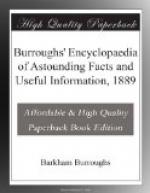The custom of placing the address beneath the body instead of at the beginning of the letter, is not much in vogue in business circles in this country, most business men preferring to place the name and address at the head of the sheet, and then write at it as if they were talking to the person himself. When, however, the address is placed below the letter it should occupy the same position as to the margin, etc., as if placed at the beginning. The custom is borrowed from the English, and its use is confined mostly to government officials and professional men.
BODY OF THE LETTER.
This constitutes the written message. It should begin on the same line with the words Dear Sir, or Gentlemen leaving after these words a small space. In case the place of residence or business is not written in the address, then the complimentary address of Dear Sir or Gentlemen will be placed on the next line under the name, or fourth line from the top of the sheet, and the letter will begin on the fifth line from the top, thus:
[Illustration:
Mr. Henry L. Dunham,
Dear Sir:
In answer to your esteemed favor]
Sometimes for the sake of convenience, and the saving of time and labor, the letter head has printed in the left corner, above the address, a blank form of memorandum as follows:
[Illustration:
Referring to
yours of...
OR,
In
reply to
your favor of...,]
and after this introduction the writer is able speedily to get at the marrow of his letter, without acknowledging the receipt of a former communication.
The body of the letter should be divided into as many paragraphs as there are distinct subjects in the letter, or a new paragraph should be commenced at every change of the subject. The habit which some persons have of tacking one subject to the end of another, and thus making a letter one continuous paragraph of mixed up information, instructions and requests, is extremely objectionable. It destroys the force of what is said, instead of fixing each thought clearly on the mind of the reader; it leaves him confused, and he reads a second time and tries to get his ideas fixed and systematized, or he throws aside the letter until he has more time in which to study it and get the meaning clear.
If the letter is long and is really concerning only one subject, then it may properly be divided into paragraphs by separating the different divisions of the subject, and giving a paragraph to each. These should be arranged in their logical order. Wherever the letter is to contain numerous paragraphs to avoid omitting any of the items, it is best to jot them down on a slip of paper, then embody them in the letter in their natural order.




